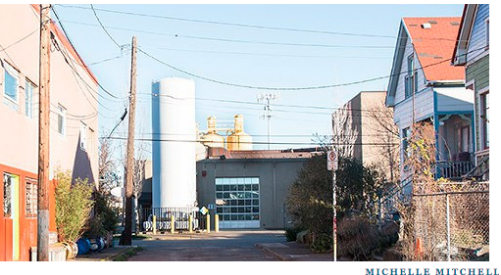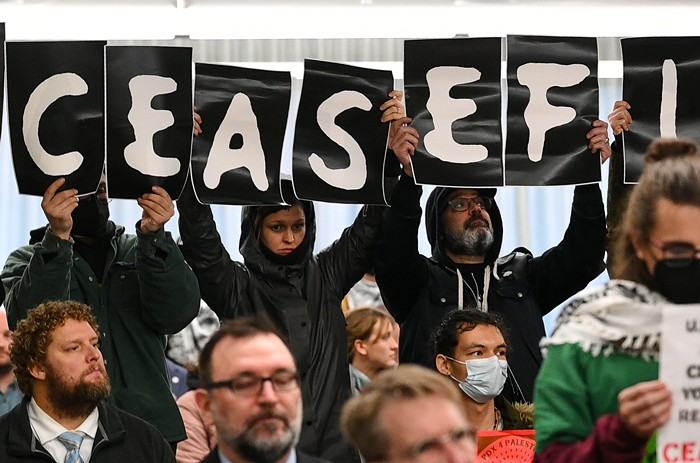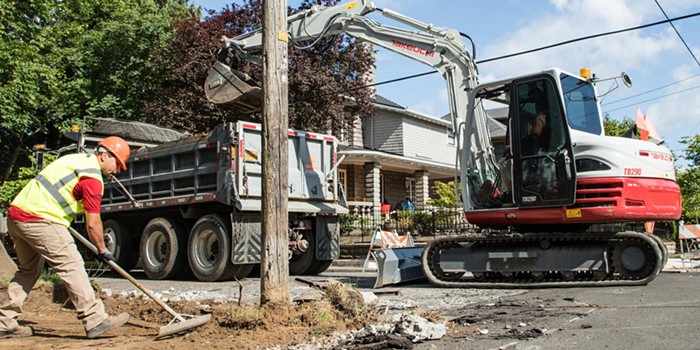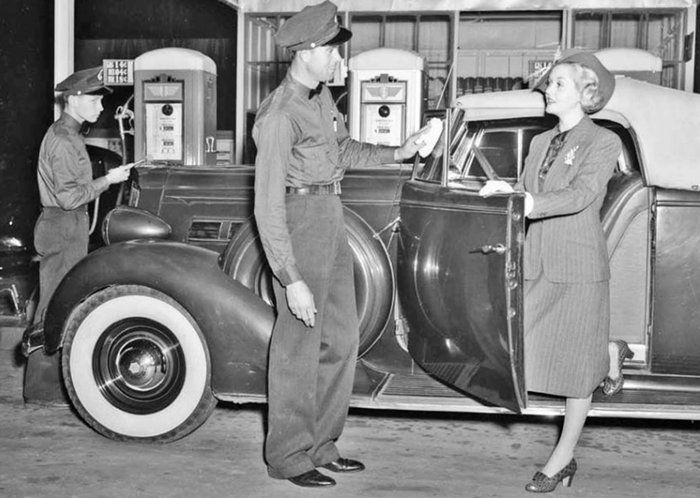
ON MARCH 4, a lawyer for Bullseye Glass emailed the state Department of Justice and Department of Environmental Quality (DEQ) to ask to start using trivalent chromium (Cr III).
For weeks, Bullseye had been forced to stop using chromium—both the rampant carcinogen hexavalent chromium (Cr VI) and its relatively benign cousin, Cr III. And, according to Bullseye, the stoppage was presenting enormous problems.
“Bullseye needs to make some glass using Cr III to stay in business,” the email said. “Due to prior contractual commitments, Bullseye must make glass with Cr III.” Failure to do so, it said, “will cause substantial economic hardship to Bullseye.”
Yet, despite all the talk of the Cr III the company needed to use starting that Monday, on March 11 (Friday of that same week) the only chromium the Oregon State Fire Marshal’s Office found on site was up to 5,498 pounds of hexavalent chromium. There were no Cr III compounds of any sort, though the scheduled, on-site audit was several days after Bullseye's requested start-date for using Cr III.
Bullseye's neighbors might well wonder: Had the company been granted DEQ's blessing to proceed that Monday—with no Cr III on hand and the company itching to commence—might it have melted the hexavalent chromium it had rather than the Cr III it apparently lacked? Would it have done so in a furnace lacking pollution control as it had been doing so blithely for decades?
This isn’t the only reason to question Bullseye’s veracity, as it readies itself to operate in a new world where years-old federal regulations suddenly apply, and its emissions are filtered for the first time.
In the frenzied months since the Mercury broke the story of alarming levels of arsenic and cadmium in the air near Bullseye’s Southeast Portland factory—which were soon followed by concerns over chromium—Bullseye has, by turns, played both the aggrieved business, and the conscientious neighbor, bent on righting unwitting misdeeds.
But the company’s recent machinations surrounding chromium use present cause for concern.
Just last week, Bullseye bent the rules governing its state-required chromium emissions test, bamboozling DEQ in the process. DEQ Air Quality Source Test Coordinator Mike Eisele wrote to Bullseye controller Eric Durrin and the company's consultant, Thomas Rhodes of Horizon Engineering, on April 12. Eisele's letter mandated: “Testing shall be performed while the furnace is making glass with the highest percentage of chromium normally used.”
Despite that requirement—and with DEQ none the wiser—Bullseye produced a type of glass that yielded scant chromium emissions. According to DEQ, the 1,200-pound batch of dark green glass Bullseye made contained 0.64 percent or 7.7 pounds, of “elemental chromium.”
But Bullseye regularly makes something called green aventurine glass, which is listed numerous times in its catalog. And, according to industry experts, a 1,200-pound batch of aventurine glass has anywhere from 5 percent to 10 percent of elemental chromium in the finished glass. At the high end, that's approximately 82 pounds of chromium itself. Some of the estimates were a bit lower, but they coalesced around the aventurine glass containing between 8 and 10 times as much chromium as the dark green glass Bullseye foisted off on DEQ for the test.
In a third dubious instance, Bullseye formally told the Mercury in an email some seven weeks ago that it intended to use a Cr III compound, chrome oxide, to make its green glass. But three experienced glassmen have told the Mercury that chrome oxide is unsuitable for making art-glass due to its tendency to leave small back specks or “stones” in the finished product.
One glassmaker said, “[U]sing chrome oxide is an incredibly difficult way to get chrome into solution in glass. One would go in many directions to avoid even trying....”
Given these observations, we questioned Bullseye’s claims about chrome oxide. Owner Daniel Schwoerer declined an invitation to offer proof.
Nor did DEQ know the type of Cr III Bullseye intended to use. DEQ engineer George Davis inquired on the Mercury's behalf after Schwoerer was told of the doubts. Only then, three days after the company stating it'd use solely chrome oxide, did Bullseye change its tune and tell Davis it also intended to use another Cr III compound, iron chromite.
Perhaps the most stark cause for concern comes from the past. To escape EPA regulation back in 2007, Bullseye told the feds it used no arsenic. This though it reported to the DEQ that same year that it used 4,681 pounds of arsenic trioxide.
Concerns regarding Bullseye's veracity are especially troubling since DEQ is seemingly without the resources to challenge manufacturers on issues of glass chemistry. The agency trusts, but lacks the necessary expertise to verify, as is demonstrated by its April 27 release: “On a recent site visit to Bullseye Glass Company, a DEQ inspector reviewed the list of ingredients used in a batch of glass production and chromium was not on the list.”
Take it to the bank in the hope Bullseye didn't draw up the list using a pencil with an eraser.
Much of DEQ's regulation of polluters statewide is like this: Entirely dependent on valid facility self-reporting. So the public being able to trust the companies in their midst carries a great deal of weight. It's a load Bullseye has dumped painfully on DEQ's toes—and its own.
Let's unpack the assertions above.
The first is pretty straightforward. On Friday, March 4, Bullseye's lawyer, Jeffrey Hunter of Perkins Coie LLP, wrote to DOJ's Paul Garrahan, acting as DEQ's counsel, and to DEQ compliance and enforcement manager Leah Feldon to demand the right to start making Cr III glass from naked stacks the following Monday.
Following the urgent pleas quoted above, came an obvious shot over DEQ's bow: Hunter requested that his email warning of the company possibly closing—and taking 140 or so jobs with it—be forwarded to the governor's office.
Hunter was writing after 5 pm on a Friday, and Bullseye was looking to commence the following Monday. Yet the company possessed no trivalent chromium according to the on-site audit conducted by the state fire marshal’s office on March 11, four days after the projected start-date.
Brent Griffiths of the fire marshal's Community Right To Know Program stated, “Nothing in the auditor's report or his notes indicates the presence of iron chromite during our audit at Bullseye Glass.” The same was true of chrome oxide—the Cr III compound Bullseye would claim it intended to use. In fact, aside from at least 1,200 pounds of two hexavalent chromium compounds, “nothing in the auditor's report or notes indicates the presence of any other chromium.” (Bullseye has since obtained some Cr III iron chromite to use making its dark green test-run glass, according to what it told DEQ.)
Initially, Bullseye didn't shy from its hexavalent chromium use. On February 12—early on in the air toxics crisis before Bullseye got religion on the carcinogen—a company press release referred to “hexavalent chromium, an industry standard material lawful to use under the company's existing air quality discharge permit and DEQ's own regulations.”
Last week, Davis stated, “DEQ is aware that Bullseye has used chromium VI in the past and may wish to use it in the future…. DEQ expects to set limits on the amount of chromium III used, as well as the amount of chromium VI used if chromium VI will be used in the future.” And indeed the new state rules governing glass production permit use of the poison Erin Brokovich ushered into the Toxics Hall of Shame twenty years ago and more.
Then there's the second matter, the shaky emissions test DEQ wants to hang its hat on regarding how much Cr III is converted to Cr VI in the heat of a 2,500-degree Fahrenheit glass-melt furnace. (Peer-reviewed, scholarly research indicates it may be half and more.) It's a test geared to allow DEQ to understand what comes out of a glass company's smoke stacks so the agency can regulate allowable chromium use.
For the monitoring, Bullseye was ordered to make a chromium-rich glass resulting in high Cr VI emissions; a route to DEQ knowing the amount of poison released. Yet the company’s dark green glass has somewhere in the neighborhood of only 10 percent the chrome of its aventurine glass. DEQ perhaps fell victim to a sort of specious logic regarding the test's “dark” glass: if chromium makes green glass, it must take a lot of it to make dark green glass.
In fact, it's the yellowish, lime-greens that employ hexavalent chromium in the batch. Without some understanding of how much chromium those products emit, DEQ should consider banning lime-green and related yellowish greens, or be Johnnie-on-the-spot monitoring hexavalent chromium readings the days they're making it.
The same goes for the days the company makes aventurine glass, according to two accomplished glassmakers, who we’ve called “Ted” and “Archie.” The men were introduced to Mercury readers discussing Bullseye and its North Portland competitor, Uroboros Glass's use of fluorine. Both decline to use their real names, fearful of blowback in the insular art-glass world.
Archie says, “True aventurines have super-saturations of chrome in them to the point of having crystalline structures [of chromium] forming in the glass….” The Bullseye catalog refers to its aventurine glass as “supersaturated chrome glass with metal flake glints in reflected light.”
Spell it with a dash or not, 'super-saturated' means a whole mess of chromium.
“Ted,” though located far from Portland on a distant shore, should be considered a competitor to Bullseye. That said, his insights withstand scrutiny. Besides, Bullseye’s certainly not answering any questions about glass chemistry these days.
Ted notes: “It would be very easy … to arrange an exhibition test-melt for DEQ making, say, a dark-emerald green” for an outcome “as favorable as possible re Cr VI emissions.”
He added, “We can be absolutely certain that Bullseye will engineer this particular green color to be the most optimum for reducing the Cr VI species. They will use iron chromite [as Bullseye did, DEQ said] and reduce it heavily with carbon or some other reducing chemical. That way they will try to ensure that all the Cr in the glass is trivalent.”
DEQ's engineer, Davis, emailed to acknowledge that the agency’s “source test plan approval letter specified that a glass with the highest chromium and highest oxidizing conditions [oxidation is a loss of electrons that converts Cr III to Cr VI] must be used for the source test.” But the agency let Bullseye choose the type of glass “in consultation with DEQ.” And, Davis tells the Mercury “DEQ verbally amended the requirement to specify the highest chromium content in a glass that Bullseye routinely makes, not a glass that they could make, bur rarely do.”
Bullseye’s catalog prominently features aventurine glass products.
Referring to the test protocol, Ted said, “There is no mention of testing a batch from their standard recipe book that might generate Cr VI like the aventurines and lime greens. How curious. Was Bullseye allowed to choose a green for the test which is extremely convenient for them?”
Ted figures an aventurine has “maybe 10x” the chromium content as the test glass. The Mercury asked DEQ whether they knew of this “Bullseye product that is approximately 8% chromium compound as raw material.”
Davis replied, “We cannot verify your information, and suspect it may be in error." But he made no mention of aventurines.
While DEQ knows the finished dark green test glass's chromium content, it says Bullseye refuses to reveal how much Cr III compound was initially tossed into the furnace. “That information is confidential business information, and DEQ does not have it,” said Davis. This despite the fact that Eisele's 'mandate' letter demanded to know the “Amount of total chromium in the batch (lbs). Type and quantity of material being processed.”
Essentially, DEQ got the brush-off from a company it suspects on two separate occasions last October released total chromium (that is, both hexavalent and trivalent chromium) in excess of 5,000 times the state’s annual safe-air goal for Cr VI. As noted in Cascadia Times, scientific data argue that half that total chromium was Cr VI. (The state of California says to treat all chromium emissions as Cr VI).
So twice last year perhaps 2,500-times Oregon's annual safe-air goal for one of the half-dozen fiercest poisons on the planet fouled the air around Bullseye. But the company isn't saying how much chromium went into its test-run, and for DEQ—despite its test-protocol's stern admonishments—that was that.
Prompted by Bullseye's plea to start Cr III production two weeks prior, the Mercury asked Bullseye spokesperson Chris Edmonds on March 18 what type and how many pounds of Cr III Bullseye had on hand to make the 30 percent of its glass that's green.
Bullseye had been saying for weeks that it needed to use trivalent chromium to make its greens—but what kind? There are several Cr III compounds, all with various glass-chemistry properties. DEQ didn't know what type, as was acknowledged to the Mercury by DEQ then acting director Joni Hammond, by Northwest Region Administrator, Nina DeConcini and by Leah Feldon, the agency's chief of compliance and enforcement.
Edmonds told us that “Bullseye uses green chrome oxide in its glass melts.” Uses, as in the present tense. The Mercury then sent an email to Bullseye owner Dan Schwoerer and his lieutenant, Eric Durrin, quoting three glassmakers on the general unsuitability of using chrome oxide for making green art glass.
One expert, Eric Miller, has worked for both Bullseye and Uroboros. Miller said, “Cr III was not commonly used when I was working with either company.” He added that chrome oxide is “very tough to melt, and it leaves dark specks in the glass.”
Tough to melt as in you have to heat the heck out of it at considerable expense. Some in glass consider Chemical Approach to Glass by Milos B. Volf the reference of choice. Volf writes, “Chromium (III) oxide shows poor solubility in glass owing to its high melting point (1900 C).” That's 3,452-degrees Fahrenheit, or approximately 1,000 degrees hotter than a glass furnace's normal upper range. And over an 8-hour or longer glass melt, the expense of keeping a gas-fired furnace running 1,000 degrees hotter adds up.
Volf also notes chrome oxide's “poor miscibility,” meaning it doesn't mix well with other raw ingredients. Hence the dark “specks” or “stones” that might turn an expensive piece of glass into trash.
Ted wrote to say, “Bullseye and Uroboros almost certainly would be using Potassium dichromate”—or perhaps another hexavalent compound, sodium dichromate—“for nearly all their greens. It is the most oxidising of the chromates and the easiest to melt without creating chrome stones, which are undesirable.”
In a subsequent email, he put it plainly: “To my knowledge, glassmakers don't normally use any form of trivalent chrome as a batch material.”
Based on these and other assertions, including the authoritative Volf text, the email to Schwoerer asked to come to the factory and see in its original packaging the chrome oxide it claimed to use. Jim Jones, Bullseye Director of Sales sent a one-sentence reply that addressed none of the issues at hand. But very shortly thereafter the company told DEQ it intended to use another Cr III compound, iron chromite.
There'd been no mention of iron chromite in four emails to the Mercury that weekend.
In 2007, Bullseye was able to convince the EPA that it shouldn't fall under federal regulation. The main escape route was telling the agency that its furnaces were 'periodic' rather than 'continuous,' and so therefore should not be regulated. That's since been rescinded following coverage from the Mercury.
But around the same time, an EPA employee named Susan Fairchild reported that Durrin, Bullseye’s controller, told the EPA that “None of their batches contain lead or arsenic." She reported this in the formal docket of comments on the feds' proposed rule changes.
But that same year, in Bullseye's Annual Report to the DEQ, signed by Durrin, Bullseye reported using 4,681 pounds of arsenic trioxide.
Given the wool Bullseye pulled over DEQ's eyes, then tied tightly round its neck, many of the company's neighbors have little confidence in the agency's ability to bird-dog the technical challenge of determining what levels of chromium usage lead to what levels of hexavalent chromium inhaled by children playing in their backyards—not when the company won't even tell DEQ what it puts in its furnaces. Especially since the state's rules don't require actual air monitoring to gauge the risk, but instead rely on computer models.
With no Cr III in the state fire marshal's reportable quantity (500 pounds ore more) on hand for more than a year, it seems possible Bullseye normally put 60 or 80 or more pounds of a hexavalent chromium compound into its furnaces to make aventurine glass.
Both Ted and Archie believe the companies production of aventurine could have resulted in the chromium spikes in the air last fall that were detected by DEQ.
Those results turned up chrome readings 5,000-times the state's safe-air goals—some large portion of it the hexavalent chromium both the World Health Organization and the state of California deem toxic in any dose. And that's for adults. No one knows about kids, infants, maybe, whose lungs are doubling in size every several months.
Yet despite DEQ's written mandate to make “glass with the highest percentage of chromium normally used,” Bullseye deliberately chose a different, far more chrome-starved glass for the test-run to determine its future allowable chromium use. The company preceding in bad faith, DEQ—which obviously should have hired a glass chemist on a consulting basis months back—seems powerless to stop it.
Daniel Forbes is the author of Derail This Train Wreck. He lives in Portland, and can be reached at ddanforbes@aol.com.
MORE COVERAGE:
•State Finds Alarmingly High Arsenic, Cadmium Levels Near Two SE Portland Schools
•Too Cozy? A DEQ Air Quality Official Apparently Vacationed With An Attorney Representing Industry
•Oregon DEQ Director Dick Pedersen Resigns Amid Air Pollution Concerns
•Bullseye Glass Has Suspended Use of Arsenic and Cadmium Because of Air Quality Concerns
•Essential Pollution Controls Lacking at Two Glass Plants Blamed For Cadmium Emissions


















